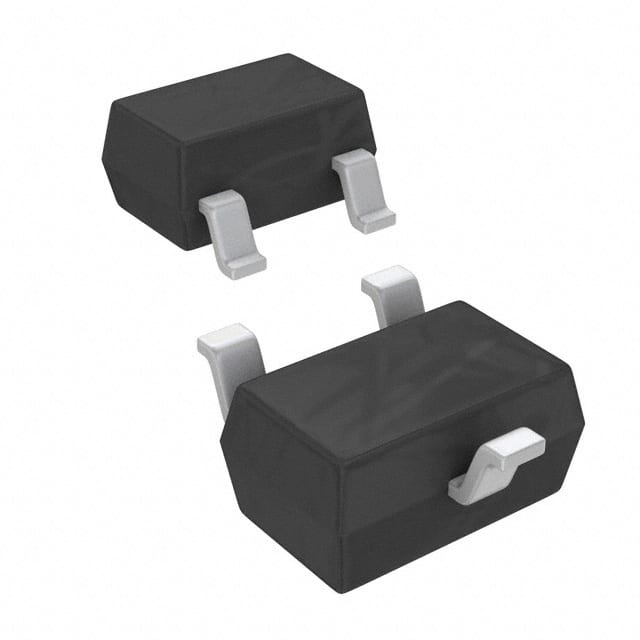BAS70WT-TP Diode: Product Overview and Specifications
Introduction
The BAS70WT-TP diode is a crucial component in the field of electronics, specifically in applications requiring rectification and signal demodulation. This entry provides an in-depth overview of the BAS70WT-TP diode, including its product category, basic information, specifications, pin configuration, functional features, advantages and disadvantages, working principles, application field plans, and alternative models.
Basic Information Overview
- Category: Diode
- Use: Rectification and signal demodulation
- Characteristics: High-speed switching, low leakage current, small package size
- Package: SOT-323
- Essence: Efficient rectification and signal demodulation
- Packaging/Quantity: Available in reels with varying quantities
Specifications
- Maximum Continuous Forward Current: 200 mA
- Reverse Voltage: 70 V
- Forward Voltage Drop: 0.715 V at 10 mA
- Reverse Recovery Time: 4 ns
Detailed Pin Configuration
The BAS70WT-TP diode has a SOT-323 package with three pins: 1. Pin 1: Anode of the first diode 2. Pin 2: Common cathode 3. Pin 3: Anode of the second diode
Functional Features
- High-speed switching capability
- Low forward voltage drop
- Low reverse recovery time
- Small package size for space-constrained applications
Advantages and Disadvantages
Advantages
- Fast switching speed
- Low power dissipation
- Compact package size
- Low leakage current
Disadvantages
- Limited maximum continuous forward current
- Relatively low reverse voltage compared to other diodes
Working Principles
The BAS70WT-TP diode operates based on the principles of semiconductor physics. When a forward bias is applied, it allows current to flow, enabling efficient rectification and signal demodulation. The fast switching speed and low forward voltage drop make it suitable for high-frequency applications.
Detailed Application Field Plans
The BAS70WT-TP diode finds extensive use in various electronic circuits, including: - RF communication systems - Signal demodulation circuits - High-frequency rectification circuits - Switching power supplies - Voltage clamping circuits
Detailed and Complete Alternative Models
Several alternative models to the BAS70WT-TP diode include: - 1N4148: A general-purpose diode with similar characteristics - BAT54S: Schottky diode with comparable specifications - BAV99: Dual diode with higher reverse voltage rating
In conclusion, the BAS70WT-TP diode is a critical component in modern electronics, offering high-speed switching and efficient rectification capabilities. Its compact package and low leakage current make it suitable for various applications, despite its limitations in maximum current and reverse voltage. Understanding its specifications, pin configuration, functional features, and alternative models is essential for successful integration into electronic circuits.
Word count: 411
Lista 10 Vanliga frågor och svar relaterade till tillämpningen av BAS70WT-TP i tekniska lösningar
What is the BAS70WT-TP diode used for?
- The BAS70WT-TP diode is commonly used for signal switching, high-speed rectification, and protection in various technical solutions.
What are the key features of the BAS70WT-TP diode?
- The BAS70WT-TP diode features low forward voltage, fast switching speed, and high reliability, making it suitable for demanding technical applications.
Can the BAS70WT-TP diode be used in high-frequency applications?
- Yes, the BAS70WT-TP diode is designed for high-frequency applications due to its fast switching characteristics.
What is the maximum forward voltage of the BAS70WT-TP diode?
- The maximum forward voltage of the BAS70WT-TP diode is typically around 0.715V at a forward current of 100mA.
Is the BAS70WT-TP diode suitable for compact designs?
- Yes, the BAS70WT-TP diode's small SOT323 package makes it well-suited for compact and space-constrained technical solutions.
Does the BAS70WT-TP diode have a low leakage current?
- Yes, the BAS70WT-TP diode exhibits low reverse leakage current, which is beneficial for precision technical applications.
Can the BAS70WT-TP diode handle high surge currents?
- The BAS70WT-TP diode has good surge handling capabilities, making it suitable for applications where transient overcurrents may occur.
What is the temperature range for the BAS70WT-TP diode?
- The BAS70WT-TP diode is designed to operate within a wide temperature range, typically from -65°C to 150°C, ensuring versatility in technical solutions.
Are there any specific layout considerations when using the BAS70WT-TP diode?
- It is recommended to minimize the length of the PCB traces connected to the BAS70WT-TP diode to reduce parasitic effects and optimize performance in technical solutions.
Where can I find detailed application notes for integrating the BAS70WT-TP diode into my technical solution?
- Detailed application notes for the BAS70WT-TP diode can be found in the product datasheet or by contacting the manufacturer's technical support team for assistance.


